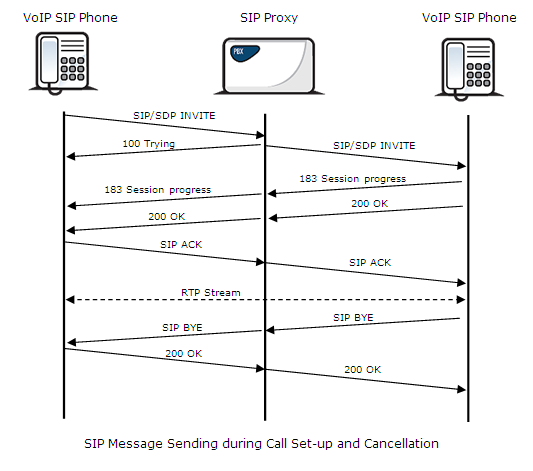2.4 IP Voice Transmission
Speech Encoding Methods
Voice transmission is strictly separated from signalling in VoIP networks. Modern VoIP networks mostly use the RTP (Realtime Transport Protocol) for voice transmission. The purpose of the RTP is only to transmit data (voice) from a source to a destination at real time. Codecs are used to save the channel data capacity. Codecs process the voice signal using variable algorithms to minimise the volume of user data. The degree of compression used by the codec affects the quality of voice transmission. Thus, the better voice transmission is required, the wider data range (the higher transmission rate) is needed. The MOS (Mean Opinion Score) scale is used for rating voice transmission quality, where 1 means the worst and 5 the best quality. For a survey of the codecs supported by 2N® VoiceBlue Next refer to the table below.
Standard | Algorithm | Transmission rate [kbps] | MOS |
G.711a | PCM | 64 | 4.1 |
G.711u | PCM | 64 | 4.1 |
G.729 * | CS–ACELP | 8 | 3.92 |
[*] G.729 is an optional part of the system.
For 2N® VoiceBlue Next, quadruple the above mentioned rates (two fully duplex calls) and add the TCP and IP header transmission rate to the result to get the resultant transmission rate.
It is important to keep both a stable appropriate transmission rate during connection and a small and identical transmission time per data packet in order to maintain a high-quality voice transmission.
- G.711 – this codec is used in digital telephone networks. The PCM (Pulse Code Modulation) is used for voice signal encoding. The sampled signal is encoded in 12 bits and then compressed using a non-linear scheme into the resultant 8 bits. Europe uses the A-law compression system while North America and Japan obey the µ-law. The resultant data flow is 64 kbps.
- G.729 – this codec uses the CS-ACELP (Conjugate-Structure Algebraic-Code-Excited Linear-Prediction) algorithm with the resultant transmission rate of 8 kbps. The speech signal is split into blocks of 10 ms each. The parameters of these blocks are then inserted in frames of the size of 10 bytes. 2-byte frames are generated for noise transmission.
During call set-up, a codec is selected automatically for voice transmission. 2N® VoiceBlue Next supports the codecs included in the table above. The type of codec to be used depends on your VoIP network (individual devices) and your 2N® VoiceBlue Next configuration. 2N® VoiceBlue Next is designed primarily for VoIP corporate networks and tries to meet the opponent's codec requirements. If a codec is requested that is incompatible with 2N® VoiceBlue Next, the call will be rejected.
The SIP and ITU-T H.323 recommended protocols are mostly used for connection establishing, maintaining and cancelling. 2N® VoiceBlue Next uses the SIP (Session Initiation Protocol) signalling.
Tip
- In the case of separated direct connection of your SIP Proxy and 2N® VoiceBlue Next, use the G.711 codec to achieve a high voice quality.
SIP Components
The following components are involved in the SIP message exchange:
- UAC (User Agent Client) – the terminal device client, which initiates SIP signalling.
- UAS (User Agent Server) – the terminal device server, which responds to SIP signalling from the UAC.
- UA (User Agent) – a SIP network terminal (SIP phones, gateways to other networks, etc.), which contains the UAC and UAS.
- Proxy server – receives connection requests from the UA and transfers them to the next Proxy server if the given station is not under it administration.
- Redirect server – receives connection requests, but, instead of sending them to the called line, sends them back to the requesting device asking for where to route the request.
- Location server – receives registration requests from the UA and updates the terminal database accordingly.
All the server components (Proxy, Redirect, Location) are mostly on one physical device called Proxy server, which is responsible for keeping a client database and connection establishing, maintaining and terminating, as well as call routing.
The 2N® VoiceBlue Next VoIP-GSM gateway acts as a UA in any case (has the same functions as a VoIP phone), i.e. receives call set-up requirements and, on the basis of its inner LCR table, routes calls to GSM networks.
None of the SIP-defined server components are integrated in the 2N® VoiceBlue Next gateway.
SIP Signalling Messages
Below is a list of messages sent via the SIP:
- INVITE – connection set-up request;
- ACK – INVITE confirmation by the final message addressee;
- BYE – connection termination;
- CANCEL – failed connection cancellation;
- REGISTER – UA registration with the SIP Proxy;
- OPTIONS – server capability query.
The answers to the SIP messages are numerically coded as the case is with the http protocol. Below are the most important ones:
- 1XX – information messages (100 – trying, 180 – ringing, 183 – progress);
- 2XX – successful request completion (200 – OK);
- 3XX – request forwarding needed (302 – temporarily moved, 305 – use Proxy);
- 4XX – error (403 – forbidden, 486 – busy here);
- 5XX – server error (500 – Server Internal Error, 501 – not implemented);
- 6XX – global failure (606 – not acceptable).

